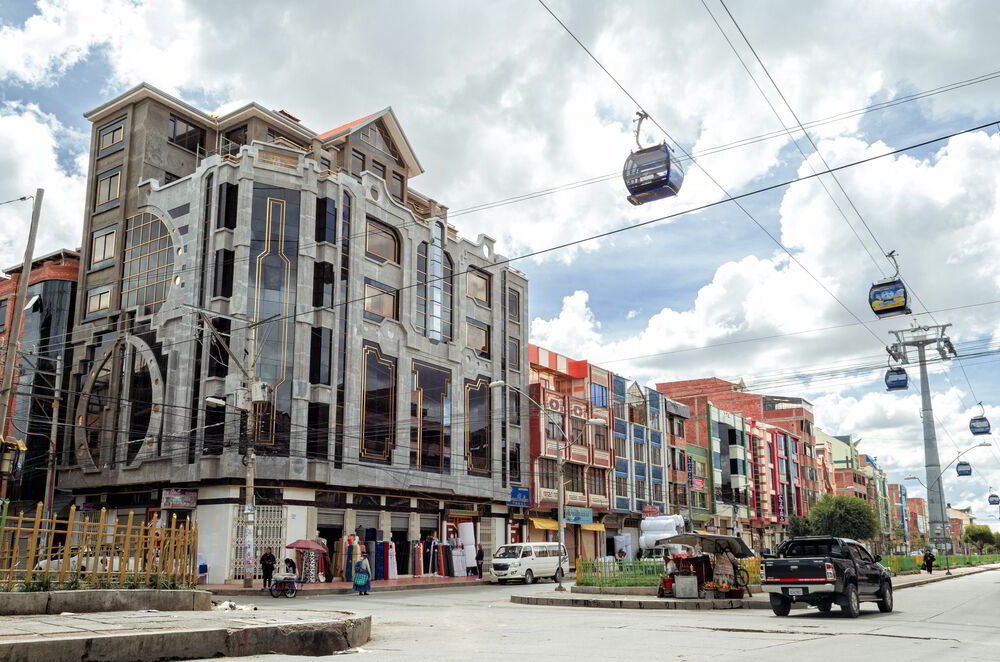22 Nov 2021 | Ruben Darío Chambi
El Alto: Indigeneity in an Aymara city
I am from El Alto, one of the youngest cities in Bolivia, not only because of its recent creation (1985), but also because at least 45% of its population is under 19 years old. With 848,000 inhabitants, it is the second largest city in Bolivia and one of the highest in the world, at 4,150 metres above sea level.
I remember as a child when neighbours came from the different provinces of the altiplano. As the Alteño journalist Marco Alberto Villca used to say, El Alto “is a town of towns”, since, even today, it is still possible to identify, in the composition of its neighbourhoods, the origins of its inhabitants.
 A street in the city of El Alto. Photo: Alice Coronel, 2021.El Alto is the result of the country’s misguided policies. In the 1980s, the lack of land, as a result of a poorly planned agrarian reform and a severe drought, led to the migration of Aymara families to this place. This coincided with the fall in international tin prices, and thousands of mining workers were “relocated”, a term used at the time to refer to the forced withdrawal from their jobs. They also looked to El Alto for a new start.
A street in the city of El Alto. Photo: Alice Coronel, 2021.El Alto is the result of the country’s misguided policies. In the 1980s, the lack of land, as a result of a poorly planned agrarian reform and a severe drought, led to the migration of Aymara families to this place. This coincided with the fall in international tin prices, and thousands of mining workers were “relocated”, a term used at the time to refer to the forced withdrawal from their jobs. They also looked to El Alto for a new start.
From the beginning, the inhabitants of El Alto, through their organizations, took responsibility for the construction of streets, houses and basic services in a city that had been poorly planned. In this process, the Alteños managed to combine the organizational structures of the Aymara communities with the mining union, which is one of its characteristics to this day.
Over the years, the city acquired its own identity. The adobe houses gave way to concrete, glass and brick, creating new forms of architecture, what today some call “neo-Andean”, which could well be the Aymara representation of modernity.
This transformation cannot be explained without mentioning another central factor in the identity of this city, the market or “K’hatu” (in the Aymara language). In the absence of employment policies, its inhabitants found in the informal economy a source of subsistence and economic positioning. Street markets are now part of the city’s landscape, allowing the formation of traders’ organizations, mostly made up of women.
During the political crisis of 2003 in Bolivia, social organizations in this city gained notoriety. Their capacity for mobilization was decisive in putting an end to the neoliberal era and allowing for the beginning of the current Plurinational State, a term that implies the incorporation of Indigenous peoples into the state.
At the national level, El Alto is today a central actor in the negotiations for political power achieved by Indigenous peoples in the Bolivian state and society. But it also represents, in many ways, a response to institutional narratives about Indigenousness, which portray these peoples as societies anchored in ancestral knowledge, life in in community and nature, and an economy of reciprocity. The “Buen Vivir” (Living Well) is the culmination of these official narratives, presented as belonging to Indigenous peoples.
In the face of these official discourses, El Alto goes against the tide. The country’s most important Indigenous city is dynamic and pursues to incorporate itself into an interconnected world by developing entrepreneurship and seeking markets. In the midst of this process, it promotes its identity through the exercise of the Aymara language and traditions in creative ways. For many, these characteristics show a city that has lost its Indigenous identity. For others, it is a sign of vigour and dynamism.
The processes of modernity in which its inhabitants are immersed turn El Alto into a prime site in which to conduct ethnographic work on Aymara Indigeneity, It poses diverse scenarios of identity in which I, as a researcher and Alteño, feel myself immersed.

